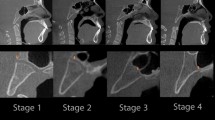Abstract
Objective
This cross-sectional study aimed to investigate the association between the occipital spur length and craniofacial morphology in individuals with occipital spur (OS).
Methods
The study included cephalometric images from 451 individuals (196 females, 255 males, age range was 9–84 years). The spur length and craniofacial characteristics were evaluated using cephalograms. Based on spur length, subjects were divided into two groups: the OS group (N = 209) and the enlarged occipital spur (EOS) group (N = 242). Descriptive statistics, Independent T-test, Mann–Whitney U test, chi-square test, Kruskal–Wallis test, and age- and sex-based stratified analyses were performed. The level of significance was set at p < 0.05.
Results
Males had significantly larger spur length than females. Spur length was shorter in individuals under 18 than the groups over 18. After adjusting for gender and age, ramus height, mandibular body length, effective length of maxilla, effective length of mandible, anterior cranial base length, posterior cranial base length, anterior facial height, posterior facial height, facial height index, and lower anterior facial height had statistically significant differences between OS group and EOS group.
Conclusions
Males exhibit greater spur length than females. Patients under 18 had a shorter spur length than adults. Linear craniofacial measurements were found to be greater in subjects with EOS than the individuals with OS. The craniofacial growth and development of an individual might be associated with EOS. The causal relationship between EOS and craniofacial development requires further longitudinal studies.




Similar content being viewed by others
References
Gunacar DN, Gonca M, Kose TE. Occipital spurs on lateral cephalometric radiographs: morphologic and morphometric features. Oral Radiol. 2021;38:416–21. https://doi.org/10.1007/s11282-021-00574-y.
Varghese E, Samson RS, Kumbargere SN, Pothen M. Occipital spur: understanding a normal yet symptomatic variant from orthodontic diagnostic lateral cephalogram. BMJ Case Reports. 2017;2017:bcr-2017-220506.
Shahar D, Sayers MGL. A morphological adaptation? The prevalence of enlarged external occipital protuberance in young adults. J Anat. 2016;229(2):286–91.
Gómez Zubiaur A, Alfageme F, López-Negrete E, Roustan G. Type 3 external occipital protuberance (Spine Type): ultrasonographic diagnosis of an uncommon cause of subcutaneous scalp pseudotumor in adolescents. Actas Dermo-Sifiliográficas (English Edition). 2019;110(9):774–5.
Marshall RC, Abela C, Eccles S. Painful exostosis of the external occipital protuberance. J Plast Reconstr Aesthet Surg. 2015;68(11):e174–6.
Nikita E, Michopoulou E. A quantitative approach for sex estimation based on cranial morphology. Am J Phys Anthropol. 2018;165(3):507–17.
Jacques T, Jaouen A, Kuchcinski G, Badr S, Demondion X, Cotten A. Enlarged external occipital protuberance in young French individuals’ head CT: stability in prevalence, size and type between 2011 and 2019. Sci Rep. 2020;10(1):1–9.
Takamine Y, Lachman RS, Field FM, Rimoin DL. Occipital projections in the skeletal dysplasias. Pediatric Radiol. 2004;34:530–4.
Shahar D, Sayers MG L. Prominent exostosis projecting from the occipital squama more substantial and prevalent in young adult than older age groups. Sci Rep. 2018;8(1):3354.
Shahar D, Evans J, Sayers MGL. Large enthesophytes in teenage skulls: Mechanical, inflammatory and genetic considerations. Clin Biomech. 2018;53:60–4.
Shahar D, Sayers MGL. Author Correction: Prominent exostosis projecting from the occipital squama more substantial and prevalent in young adult than older age groups. Sci Rep. 2019;9(1):13707.
Roseman CC. Random genetic drift, natural selection, and noise in human cranial evolution. Am J Phys Anthropol. 2016;160(4):582–92.
Singh R. Bony tubercle at external occipital protuberance and prominent ridges. J Craniofac Surg. 2012;23(6):1873–4.
Zhou X, Xiong X, Yan Z, Xiao C, Zheng Y, Wang J. Hyoid bone position in patients with and without temporomandibular joint osteoarthrosis: a cone-beam computed tomography and cephalometric analysis. Pain Res Manage. 2021;2021:1–10.
Xiong X, Huang Y, Liu W, Wu Y, Yi Y, Wang J. Distribution of various maxilla-mandibular positions and cephalometric comparison in Chinese skeletal class II malocclusions. J Contemp Dent Pract. 2020;21(8):822–8.
Porrino J, Sunku P, Wang A, Haims A, Richardson ML. Exophytic external occipital protuberance prevalence pre- and post-iphone introduction: a retrospective cohort. Yale J Biol Med. 2021;94(1):65–71.
Solow B, Kreiborg S. Soft-tissue stretching: a possible control factor in craniofacial morphogenesis. Eur J Oral Sci. 1977;85(6):505–7.
Gomes LDCR, Horta KOC, Goncalves JR, Santos-Pinto AD. Systematic review craniocervical posture and craniofacial morphology. Eur J Orthod. 2014;36(1):55–66.
Acknowledgements
We would like to thank the participation of all radiologists, respondents, as well as the anonymous reviewers for their helpful remarks.
Funding
This research was supported by National Natural Science Foundation of China (No. 82271019, 81970967), Sichuan Health Commission Medical Science and Technology Program (21ZD003) and Research and Develop Program, West China Hospital of Stomatology Sichuan University (RD-03–202101) to J. W.
Author information
Authors and Affiliations
Corresponding author
Ethics declarations
Conflict of interest
The authors declare that there are no conflicts of interest related to the manuscript.
Ethical approval
All procedures followed were in accordance with the ethical standards of the responsible committee on human experimentation (Institution Review Board of the West China Hospital of Stomatology, Sichuan University, China) and with the Helsinki Declaration of 1975, as revised in 2008 (5).
Informed consent
Informed consent was obtained from all individual participants included in the study.
Data availability
The authors declare that all data supporting the findings of this study are available in the article.
Additional information
Publisher's Note
Springer Nature remains neutral with regard to jurisdictional claims in published maps and institutional affiliations.
Supplementary Information
Below is the link to the electronic supplementary material.
Rights and permissions
Springer Nature or its licensor (e.g. a society or other partner) holds exclusive rights to this article under a publishing agreement with the author(s) or other rightsholder(s); author self-archiving of the accepted manuscript version of this article is solely governed by the terms of such publishing agreement and applicable law.
About this article
Cite this article
Cheng, Q., Xiong, X., Li, Y. et al. Enlarged occipital spur and craniofacial morphology: a cephalometric analysis. Oral Radiol 39, 743–749 (2023). https://doi.org/10.1007/s11282-023-00694-7
Received:
Accepted:
Published:
Issue Date:
DOI: https://doi.org/10.1007/s11282-023-00694-7




